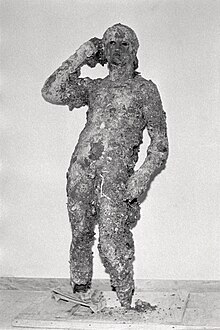Victorious Youth
The Victorious Youth was found in the summer of 1964 in the sea off Fano on the Adriatic coast of Italy, snagged in the nets of an Italian fishing trawler.
The research and conservation of the Victorious Youth dates from the 1980s to the 1990s and is based on studies in classical bronzes by ancient Mediterranean specialists in collaboration with the Getty Museum.
The entire sculpture was cast in one piece through a casting technique called the lost wax method: the sculpture was first created in clay with support to allow hot air to melt the wax, creating a mold for molten bronze to be poured into and making the large bronze Victorious Youth.
Multiple interpretations of where the Youth was made and who the Youth is are expressed in scholarly books by Jiri Frel, Paul Getty Museum curator from 1973 to 1986, and Carol Mattusch, professor of art history at George Mason University specializing in Greek and Roman art with a focus on classical bronzes.
Other research has developed an argument that the Bronze represents a victorious athlete and a young prince whose lineage relates to Alexander the Great.
In addition to the wreath, the statue's build gives clues as to the subject: this individual is a slender young man with a confident gaze, but nothing about him refers to strength; his body is not particularly muscular or powerful in its stance.
Surrounding the armature was a mixture of loam, sand, pebbles, pistachio nuts, fragments of clay and ivory, and glue.
As the wax melted, an air space formed, creating a mold of the Victorious Youth, which became filled with molten bronze.
In addition to the application of bone, copper, glass, ivory, the bronze would be painted pale and gleaming like flesh to its viewers of the ancient world.
[4] In the late 1980s antiquity scholars and Getty Museum curator Jiri Frel used radiocarbon dating and stylistic analysis to attribute the Youth to Lysippos.
The curved body, raised hip, and smooth and youthful anatomy are characteristics of a universal style—the fifth century BCE developed these frameworks as a canonical expression of classical values.
Like many other bronzes, the Victorious Youth traveled across the Mediterranean on its way to Italy for reinstallation, possibly in public areas or in private homes.
[2] The least controversial theory is that the strong calves emphasize his athletic abilities, making him an Olympic runner who held a victor's palm branch in his left arm.
[8] Interpreting the anatomy is important in identifying the statue, from the detail in the joints, delicate attention to the wrists and ends of fingers there is a youthful representation.
The victors received wreaths of different leaves depending on the site location: laurel at Delphi, olive at Olympia, pine at Isthmia, and wild celery at Nemea.
Jiri Frel in 1982 examined the statue and associated it with Alexander the Great, based on the stance and other features representing not just a well-bred citizen but one higher in class.
Now much debate and research is specific to anatomy, date and authorship, but with the uncertainties of stylistic assessments it is difficult to reach a consensus.
The Victorious Youth was found in the summer of 1964 in the sea off Fano on the Adriatic coast of Italy, snagged in the nets of an Italian fishing trawler, the Ferri Ferruccio.
[1] Before conservation, a thick layer of encrustation covered the statue, suggesting it has been immersed since antiquity, rather than as a result of medieval or late Venetian ships transporting the object as spoils of war or recycling it for scrap metal.
In 1972 Heinz Herzer and Volker Kinnius, the Munich gallery owner, wrote a report on the conservation project of Rudolph Stapp.
On that same day the public prosecutor of Pesaro formally requested that the statue be confiscated as it was unlawfully exported out of Italy, giving rise to a dispute that came before the Constitutional Court.
[13] However, on November 30, 2018, the Supreme Court of Cassation denied an appeal by the Getty Museum, affirming that Italy has a right to reclaim the Victorious Youth.



